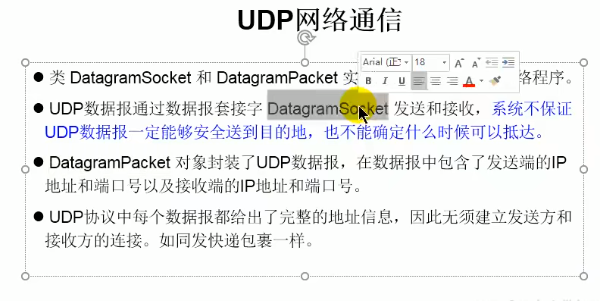Java网络编程
在Java中使用InetAddress类代表IP
实例化InetAddress:两个方法:getByName(String host) 、 getLocalHost()两个常用方法:getHostName() / getHostAddress()
套接字编程的练习
//练习1:客户端发送信息给服务端,服务端将数据显示在控制台上
try {
//File file = new File("hello.txt");
InetAddress inet1 = InetAddress.getByName("192.168.10.14");
System.out.println(inet1);
InetAddress inet2 = InetAddress.getByName("www.atguigu.com");
System.out.println(inet2);
InetAddress inet3 = InetAddress.getByName("127.0.0.1");
System.out.println(inet3);
//获取本地ip
InetAddress inet4 = InetAddress.getLocalHost();
System.out.println(inet4);
//getHostName()
System.out.println(inet2.getHostName());
//getHostAddress()
System.out.println(inet2.getHostAddress());
} catch (UnknownHostException e) {
e.printStackTrace();
}
套接字封装类Socket(TCP)
练习1:客户端发送信息给服务端,服务端将数据显示在控制台上
public class TCPTest1 {
//客户端
@Test
public void client() {
Socket socket = null;
OutputStream os = null;
try {
//1.创建Socket对象,指明服务器端的ip和端口号
InetAddress inet = InetAddress.getByName("127.0.0.1");
socket = new Socket(inet,8899);
//2.获取一个输出流,用于输出数据
os = socket.getOutputStream();
//3.写出数据的操作
os.write("你好,我是客户端mm".getBytes());
} catch (IOException e) {
e.printStackTrace();
} finally {
//4.资源的关闭
if(os != null){
try {
os.close();
} catch (IOException e) {
e.printStackTrace();
}
}
if(socket != null){
try {
socket.close();
} catch (IOException e) {
e.printStackTrace();
}
}
}
}
//服务端
@Test
public void server() {
ServerSocket ss = null;
Socket socket = null;
InputStream is = null;
ByteArrayOutputStream baos = null;
try {
//1.创建服务器端的ServerSocket,指明自己的端口号
ss = new ServerSocket(8899);
//2.调用accept()表示接收来自于客户端的socket
socket = ss.accept();
//3.获取输入流
is = socket.getInputStream();
//不建议这样写,可能会有乱码
// byte[] buffer = new byte[1024];
// int len;
// while((len = is.read(buffer)) != -1){
// String str = new String(buffer,0,len);
// System.out.print(str);
// }
//4.读取输入流中的数据
baos = new ByteArrayOutputStream();
byte[] buffer = new byte[5];
int len;
while((len = is.read(buffer)) != -1){
baos.write(buffer,0,len);
}
System.out.println(baos.toString());
System.out.println("收到了来自于:" + socket.getInetAddress().getHostAddress() + "的数据");
} catch (IOException e) {
e.printStackTrace();
} finally {
if(baos != null){
//5.关闭资源
try {
baos.close();
} catch (IOException e) {
e.printStackTrace();
}
}
if(is != null){
try {
is.close();
} catch (IOException e) {
e.printStackTrace();
}
}
if(socket != null){
try {
socket.close();
} catch (IOException e) {
e.printStackTrace();
}
}
if(ss != null){
try {
ss.close();
} catch (IOException e) {
e.printStackTrace();
}
}
}
}
//服务端,转换流实现
@Test
public void server2() throws IOException {
ServerSocket ss = null;
Socket socket = null;
InputStream is = null;
//1.创建服务器端的ServerSocket,指明自己的端口号
ss = new ServerSocket(8899);
//2.调用accept()表示接收来自于客户端的socket
socket = ss.accept();
//3.获取输入流
is = socket.getInputStream();
InputStreamReader isr = new InputStreamReader(is,"utf-8");
//4.读写过程
char[] cbuf = new char[3];
int len;
while((len = isr.read(cbuf)) != -1){
for(int i=0;i<len;i++){
System.out.print(cbuf[i]);
}
}
//3.关闭资源
isr.close();
}
}
练习2:客户端向服务器发数据(图片),服务器返回消息
PS:TCP在发送完流连接之后,需要socket.shutdown来表示(流)数据传输的结束
public class TCPTest3 {
/*
这里涉及到的异常,应该使用try-catch-finally处理
*/
@Test
public void client() throws IOException {
//1.
Socket socket = new Socket(InetAddress.getByName("127.0.0.1"),9090);
//2.
OutputStream os = socket.getOutputStream();
//3.
FileInputStream fis = new FileInputStream(new File("beauty.jpg"));
//4.
byte[] buffer = new byte[1024];
int len;
while((len = fis.read(buffer)) != -1){
os.write(buffer,0,len);
}
//关闭数据的输出
socket.shutdownOutput();
//5.接收来自于服务器端的数据,并显示到控制台上
InputStream is = socket.getInputStream();
ByteArrayOutputStream baos = new ByteArrayOutputStream();
byte[] bufferr = new byte[20];
int len1;
while((len1 = is.read(buffer)) != -1){
baos.write(buffer,0,len1);
}
System.out.println(baos.toString());
//6.
fis.close();
os.close();
socket.close();
baos.close();
}
/*
这里涉及到的异常,应该使用try-catch-finally处理
*/
@Test
public void server() throws IOException {
//1.
ServerSocket ss = new ServerSocket(9090);
//2.
Socket socket = ss.accept();
//3.
InputStream is = socket.getInputStream();
//4.
FileOutputStream fos = new FileOutputStream(new File("beauty2.jpg"));
//5.
byte[] buffer = new byte[1024];
int len;
while((len = is.read(buffer)) != -1){
fos.write(buffer,0,len);
}
System.out.println("图片传输完成");
//6.服务器端给予客户端反馈
OutputStream os = socket.getOutputStream();
os.write("你好,美女,照片我已收到,非常漂亮!".getBytes());
//7.
fos.close();
is.close();
socket.close();
ss.close();
os.close();
}
}
UDP编程

//发送端
@Test
public void sender() throws IOException {
DatagramSocket socket = new DatagramSocket();
String str = "我是UDP方式发送的导弹";
byte[] data = str.getBytes();
InetAddress inet = InetAddress.getLocalHost();
DatagramPacket packet = new DatagramPacket(data,0,data.length,inet,9090);
socket.send(packet);
socket.close();
}
//接收端
@Test
public void receiver() throws IOException {
DatagramSocket socket = new DatagramSocket(9090);
byte[] buffer = new byte[100];
DatagramPacket packet = new DatagramPacket(buffer,0,buffer.length);
socket.receive(packet);
System.out.println(new String(packet.getData(),0,packet.getLength()));
socket.close();
}
URL编程
// public String getProtocol( ) 获取该URL的协议名
System.out.println(url.getProtocol());
// public String getHost( ) 获取该URL的主机名
System.out.println(url.getHost());
// public String getPort( ) 获取该URL的端口号
System.out.println(url.getPort());
// public String getPath( ) 获取该URL的文件路径
System.out.println(url.getPath());
// public String getFile( ) 获取该URL的文件名
System.out.println(url.getFile());
// public String getQuery( ) 获取该URL的查询名
System.out.println(url.getQuery());
public static void main(String[] args) {
HttpURLConnection urlConnection = null;
InputStream is = null;
FileOutputStream fos = null;
try {
URL url = new URL("http://localhost:8080/examples/beauty.jpg");
urlConnection = (HttpURLConnection) url.openConnection();
urlConnection.connect();
is = urlConnection.getInputStream();
fos = new FileOutputStream("day10\\beauty3.jpg");
byte[] buffer = new byte[1024];
int len;
while((len = is.read(buffer)) != -1){
fos.write(buffer,0,len);
}
System.out.println("下载完成");
} catch (IOException e) {
e.printStackTrace();
} finally {
//关闭资源
if(is != null){
try {
is.close();
} catch (IOException e) {
e.printStackTrace();
}
}
if(fos != null){
try {
fos.close();
} catch (IOException e) {
e.printStackTrace();
}
}
if(urlConnection != null){
urlConnection.disconnect();
}
}
}



